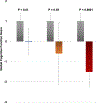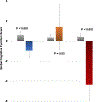Left Ventricular Mass Index Is Associated With Cognitive Function in Middle-Age: Bogalusa Heart Study
- PMID: 32772573
- PMCID: PMC7428065
- DOI: 10.1161/CIRCIMAGING.119.010335
Left Ventricular Mass Index Is Associated With Cognitive Function in Middle-Age: Bogalusa Heart Study
Abstract
Background: Elevated cardiovascular disease risk factor burden is a recognized contributor to poorer cognitive function; however, the physiological mechanisms underlying this association are not well understood. We sought to assess the potential mediation effect of left ventricular (LV) remodeling on the association between lifetime systolic blood pressure and cognitive function in a community-based cohort of middle-aged adults.
Methods: Nine hundred sixty participants of the Bogalusa Heart Study (59.2% women, 33.8% black, aged 48.4±5.1 years) received 2-dimensional echocardiography to quantify relative wall thickness, LV mass, and diastolic and systolic LV function; and a standardized neurocognitive battery to assess memory, executive functioning, and language processing. Multivariable linear regression assessed the association of cardiac structure and function with a global composite cognitive function score, adjusting for traditional cardiovascular disease risk factors. Mediation analysis assessed the effect of LV mass index on the association between lifetime systolic blood pressure burden and cognitive function.
Results: There were 233 (24.3%) and 136 (14.2%) individuals with concentric LV remodeling and concentric LV hypertrophy, respectively. Each g/m2.7 increment in LV mass index was associated with a 0.03 standardized unit decrement in global cognitive function (P=0.03). Individuals with concentric LV remodeling and isolated diastolic dysfunction had the poorest cognitive function, and a greater ratio between early mitral inflow velocity and early diastolic mitral annular velocity (E/e') was associated with poorer cognitive function, even after adjustment for LV mass index (B=-0.12; P=0.03). A total of 18.8% of the association between lifetime systolic blood pressure burden and midlife cognitive function was accounted for by LV mass index.
Conclusions: Cardiac remodeling partially mediates the association between lifespan systolic blood pressure burden and adult cognition in individuals without dementia or clinical cardiovascular disease. Slowing or reversing the progression of cardiac remodeling in middle-age may be a novel therapeutic approach to prevent cognitive decline.
Keywords: dementia; echocardiography; epidemiology; hypertension; ventricular remodeling.
Conflict of interest statement
Disclosures
None. The authors report no conflicts of interest and have no disclosures.
Figures



Comment in
-
Mediation Effect of Left Ventricular Geometric Adaptation to Lifetime Blood Pressure on Cognitive Function in Middle-Age: The Heart-Brain Connection (Partially) Explained.Circ Cardiovasc Imaging. 2020 Aug;13(8):e011325. doi: 10.1161/CIRCIMAGING.120.011325. Epub 2020 Aug 10. Circ Cardiovasc Imaging. 2020. PMID: 32772574 No abstract available.
Similar articles
-
Increased Left Ventricular Mass Index Is Associated With Compromised White Matter Microstructure Among Older Adults.J Am Heart Assoc. 2018 Jun 26;7(13):e009041. doi: 10.1161/JAHA.118.009041. J Am Heart Assoc. 2018. PMID: 29945917 Free PMC article.
-
Association Between Sleep Disordered Breathing and Left Ventricular Function: A Cross-Sectional Analysis of the ECHO-SOL Ancillary Study.Circ Cardiovasc Imaging. 2020 May;13(5):e009074. doi: 10.1161/CIRCIMAGING.119.009074. Epub 2020 May 15. Circ Cardiovasc Imaging. 2020. PMID: 32408831 Free PMC article.
-
Association of Insulin Resistance and Glycemic Metabolic Abnormalities With LV Structure and Function in Middle Age: The CARDIA Study.JACC Cardiovasc Imaging. 2017 Feb;10(2):105-114. doi: 10.1016/j.jcmg.2016.02.033. Epub 2016 Aug 17. JACC Cardiovasc Imaging. 2017. PMID: 27544896 Free PMC article.
-
Clinical aspects of left ventricular diastolic function assessed by Doppler echocardiography following acute myocardial infarction.Dan Med Bull. 2001 Nov;48(4):199-210. Dan Med Bull. 2001. PMID: 11767125 Review.
-
The role of echocardiography in the evaluation of cardiac damage in hypertensive obese patient.High Blood Press Cardiovasc Prev. 2015 Mar;22(1):23-7. doi: 10.1007/s40292-014-0058-z. Epub 2014 May 21. High Blood Press Cardiovasc Prev. 2015. PMID: 24844198 Review.
Cited by
-
Differential restoration of functional hyperemia by antihypertensive drug classes in hypertension-related cerebral small vessel disease.J Clin Invest. 2021 Sep 15;131(18):e149029. doi: 10.1172/JCI149029. J Clin Invest. 2021. PMID: 34351870 Free PMC article.
-
Association between echocardiographic parameters of cardiac structure and function and mild cognitive impairment.BMC Cardiovasc Disord. 2025 Feb 5;25(1):85. doi: 10.1186/s12872-025-04528-8. BMC Cardiovasc Disord. 2025. PMID: 39910419 Free PMC article.
-
Cardiometabolic disease, cognitive decline, and brain structure in middle and older age.Alzheimers Dement (Amst). 2024 Apr 9;16(2):e12566. doi: 10.1002/dad2.12566. eCollection 2024 Apr-Jun. Alzheimers Dement (Amst). 2024. PMID: 38595913 Free PMC article.
-
Cross-Sectional Association Between Left Ventricular Geometric Patterns, Cortical Cerebral Microinfarcts, and Cognition.J Am Heart Assoc. 2025 Jan 21;14(2):e035522. doi: 10.1161/JAHA.124.035522. Epub 2025 Jan 17. J Am Heart Assoc. 2025. PMID: 39818861 Free PMC article.
-
Brain and cardiovascular-related changes are associated with aging, hypertension, and atrial fibrillation.Clin Auton Res. 2022 Dec;32(6):409-422. doi: 10.1007/s10286-022-00907-9. Epub 2022 Nov 21. Clin Auton Res. 2022. PMID: 36409380 Review.
References
-
- Ray Dorsey E, Elbaz A, Nichols E, Abd-Allah F, Abdelalim A, Adsuar JC, Ansha MG, Brayne C, Choi JYJ, Collado-Mateo D, et al. Global, regional, and national burden of Parkinson’s disease, 1990–2016: a systematic analysis for the Global Burden of Disease Study 2016. Lancet Neurol. 2018;17:939–953. - PMC - PubMed
-
- Livingston G, Sommerlad A, Orgeta V, Costafreda SG, Huntley J, Ames D, Ballard C, Banerjee S, Burns A, Cohen-Mansfield J, et al. Dementia prevention, intervention, and care. Lancet. 2017;390:2673–2734. - PubMed
-
- Nichols E, Szoeke CEI, Vollset SE, Abbasi N, Abd-Allah F, Abdela J, Aichour MTE, Akinyemi RO, Alahdab F, Asgedom SW, et al. Global, regional, and national burden of Alzheimer’s disease and other dementias, 1990–2016: a systematic analysis for the Global Burden of Disease Study 2016. Lancet Neurol. 2019;18:88–106. - PMC - PubMed
-
- Kramarow EA, Tejada-Vera B. Dementia Mortality in the United States, 2000–2017. Natl Vital Stat Rep. 2019;68:1–29. - PubMed
-
- Norton S, Matthews FE, Barnes DE, Yaffe K, Brayne C. Potential for primary prevention of Alzheimer’s disease: An analysis of population-based data. Lancet Neurol. 2014;13:788–794. - PubMed
Publication types
MeSH terms
Grants and funding
LinkOut - more resources
Full Text Sources

